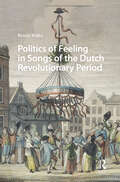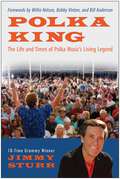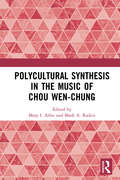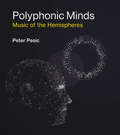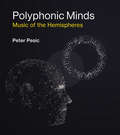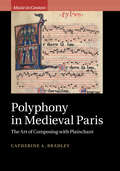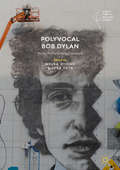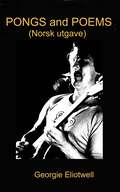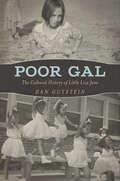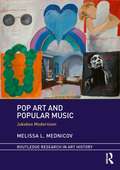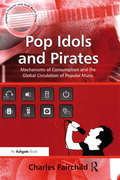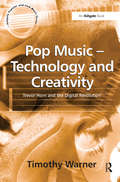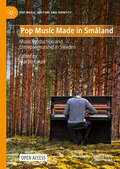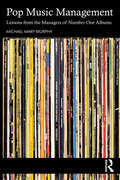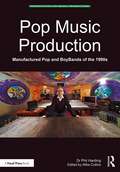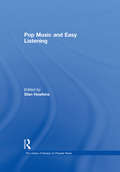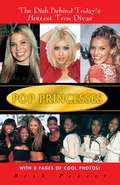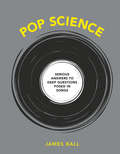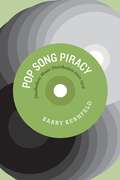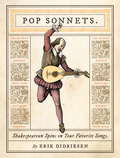- Table View
- List View
Politics of Feeling in Songs of the Dutch Revolutionary Period (Song Studies)
by Renée VultoPolitics of Feeling in Songs of the Dutch Revolutionary Period sheds new light on the intertwined history of music and politics by exploring Dutch political songs. In the emotionally charged climate of the Dutch revolutionary period at the close of the eighteenth century, songs became a powerful medium, speaking directly to people’s bodies to engage them in political action. Emphasizing the performative nature of the songs and the interplay between imagination and embodied expression in singing practices, this book shows how beyond merely creating communities, the songs were also instrumental in mobilizing, imagining, and affirming these collectives. It uncovers the diverse roles of these songs, showing how they were used both to polarize and to unite, to mourn and to celebrate. They were employed to imagine and to embody togetherness throughout the Dutch revolutionary period, thereby creating a fixed repertoire of feelings on which various political regimes of that time relied.
Polka King: The Life and Times of Polka Music's Living Legend
by Jimmy SturrArguably the most important polka practitioner of his generation, reedist/vocalist Jimmy Sturr has won an eye-popping 18 Grammy Awards, and when you hear his exuberant brand of the music that is his heart and soul, you'll understand why. Blending the timeless elements of traditional polka music with hints of country, Cajun, and rock and roll, Sturr's unique sound has taken polka to new heights of accessibility and popularity, and his modernized renditions of polka standards and renditions of rock classics have captured the imagination (and feet) of listeners throughout the world. In his memoir Polka King, you'll meet the man behind the beer barrel. In his lively, oftentimes hilarious literary debut, Jimmy chronicles how a small-town boy from tiny Florida, N.Y., made good, ultimately becoming a respected bandleader, entrepreneur, and Grammy winner with guest appearances on Saturday Night Live. He'll take you into the recording studio and onto the stage, where he's shared the microphone with the likes of Willie Nelson, The Oak Ridge Boys, and Charlie Daniels. Featuring forewords by Willie Nelson, Bobby Vinton, and &“Whispering" Bill Anderson, Polka King will introduce the world to a one-of-a-kind artist who has taken one of the world's most beloved musical genres and made it his own.
Polycultural Synthesis in the Music of Chou Wen-Chung
by Mark A. Radice Mary I. ArlinThe displacement of Chou Wen-chung from his native China in 1948 forced him into Western-European culture. Ultimately finding his vocation as a composer, he familiarized himself with classical and contemporary techniques but interpreted these through his traditionally oriented Chinese cultural perspective. The result has been the composition of a unique body of repertoire that synthesizes the most progressive Western compositional idioms with an astonishingly traditional heritage of Asian approaches, not only from music, but also from calligraphy, landscape painting, poetry, and more. Chou’s importance rests not only in his compositions, but also in his widespread influence through his extensive teaching career at Columbia University, where his many students included Bright Sheng, Zhou Long, Tan Dun, Chen Yi, Joan Tower, and many more. During his tenure at Columbia, he also founded the U.S.-China Arts Exchange, which continues to this day to be a vital stimulus for multicultural interaction. The volume will include an inventory of the Chou collection in the Paul Sacher Stiftung in Basel, Switzerland.
Polyphonic Minds: Music of the Hemispheres
by Peter PesicPolyphony -- the interweaving of simultaneous sounds -- is a crucial aspect of music that has deep implications for how we understand the mind. In Polyphonic Minds, Peter Pesic examines the history and significance of "polyphonicity" -- of "many-voicedness" -- in human experience. Pesic presents the emergence of Western polyphony, its flowering, its horizons, and the perspective it offers on our own polyphonic brains. When we listen to polyphonic music, how is it that we can hear several different things at once? How does a single mind experience those things as a unity (a motet, a fugue) rather than an incoherent jumble? Pesic argues that polyphony raises fundamental issues for philosophy, theology, literature, psychology, and neuroscience -- all searching for the apparent unity of consciousness in the midst of multiple simultaneous experiences. After tracing the development of polyphony in Western music from ninth-century church music through the experimental compositions of Glenn Gould and John Cage, Pesic considers the analogous activity within the brain, the polyphonic "music of the hemispheres" that shapes brain states from sleep to awakening. He discusses how neuroscientists draw on concepts from polyphony to describe the "neural orchestra" of the brain. Pesic's story begins with ancient conceptions of God's mind and ends with the polyphonic personhood of the human brain and body. An enhanced e-book edition allows the sound examples to be played by a touch.
Polyphonic Minds: Music of the Hemispheres (The\mit Press Ser.)
by Peter PesicAn exploration of polyphony and the perspective it offers on our own polyphonic brains.Polyphony—the interweaving of simultaneous sounds—is a crucial aspect of music that has deep implications for how we understand the mind. In Polyphonic Minds, Peter Pesic examines the history and significance of “polyphonicity”—of “many-voicedness”—in human experience. Pesic presents the emergence of Western polyphony, its flowering, its horizons, and the perspective it offers on our own polyphonic brains. When we listen to polyphonic music, how is it that we can hear several different things at once? How does a single mind experience those things as a unity (a motet, a fugue) rather than an incoherent jumble? Pesic argues that polyphony raises fundamental issues for philosophy, theology, literature, psychology, and neuroscience—all searching for the apparent unity of consciousness in the midst of multiple simultaneous experiences. After tracing the development of polyphony in Western music from ninth-century church music through the experimental compositions of Glenn Gould and John Cage, Pesic considers the analogous activity within the brain, the polyphonic “music of the hemispheres” that shapes brain states from sleep to awakening. He discusses how neuroscientists draw on concepts from polyphony to describe the “neural orchestra” of the brain. Pesic's story begins with ancient conceptions of God's mind and ends with the polyphonic personhood of the human brain and body. An enhanced e-book edition allows the sound examples to be played by a touch.
Polyphonie und Hybridität: Musikaustausch zwischen China und Europa (Studien zu Musik und Gender)
by Xuan FangIn zehn Beiträgen wird der Musikaustausch zwischen China und Europa als eine lange Geschichte von grenzüberschreitenden Begegnungen und Verflechtungen thematisiert: Im Fokus stehen zum einen Hybridbildungen im Spannungsfeld einer Rückbesinnung auf eigene Traditionen und einer Anerkennung der eigenen „Zusammengesetztheit“, zum anderen konkrete Austauschbeziehungen, also eine transkulturelle Musikvermittlung durch Lehrer*innen-Schüler*innen-Beziehungen, zum dritten die Rezeption chinesischer Musik in Europa, beginnend bei Berichten der Jesuiten im 17. Jahrhundert.
Polyphony in Medieval Paris: The Art of Composing with Plainchant (Music in Context)
by Catherine A. BradleyPolyphony associated with the Parisian cathedral of Notre Dame marks a historical turning point in medieval music. Yet a lack of analytical or theoretical systems has discouraged close study of twelfth- and thirteenth-century musical objects, despite the fact that such creations represent the beginnings of musical composition as we know it. Is musical analysis possible for such medieval repertoires? Catherine A. Bradley demonstrates that it is, presenting new methodologies to illuminate processes of musical and poetic creation, from monophonic plainchant and vernacular French songs, to polyphonic organa, clausulae, and motets in both Latin and French. This book engages with questions of text-music relationships, liturgy, and the development of notational technologies, exploring concepts of authorship and originality as well as practices of quotation and musical reworking.
Polyvocal Bob Dylan: Music, Performance, Literature (Palgrave Studies in Music and Literature)
by Nduka Otiono Josh TothPolyvocal Bob Dylan brings together an interdisciplinary range of scholarly voices to explore the cultural and aesthetic impact of Dylan’s musical and literary production. Significantly distinct in approach, each chapter draws attention to the function and implications of certain aspects of Dylan's work—his tendency to confuse, question, and subvert literary, musical, and performative traditions. Polyvocal Bob Dylan places Dylan’s textual and performative art within and against a larger context of cultural and literary studies. In doing so, it invites readers to reassess how Dylan’s Nobel Prize–winning work fits into and challenges traditional conceptions of literature.
Pongs & Poems (Norsk utgave)
by Georgie EliotwellDet er to dikt i boken – «Griller i håvet» og «Otto», resten er pongs. Ordet er en hybrid mellom ordene poem og song. Den tar de to første bokstavene fra poem og de to siste fra song. Pongene ble til i hodet mitt da jeg kjørte på motorveien til jobb. Det gikk flere år før jeg skrev dem ned. Jeg husket dem ved å «synge dem»(om man kan kalle det det) på mine daglige kjøreturer. I denne boken er det ingen musikk tillagt tekstene, men tonsetting har vært forsøkt. Om jeg prøver å synge dem stinker det. Noe som passer, ettersom pong også kan bety «stank», fordi jeg er en forferdelig sanger. Om en leser ønsker å tonesette en eller flere pongs, blir jeg svært glad om jeg fåre høre dem, så ta kontakt på sosiale medier om så er tilfelle.
Poor Gal: The Cultural History of Little Liza Jane (American Made Music Series)
by Dan GutsteinPoor Gal: The Cultural History of Little Liza Jane chronicles the origins and evolution of a folk tune beloved by millions worldwide. Dan Gutstein delves into the trajectory of the “Liza Jane” family of songs, including the most popular variant “Li’l Liza Jane.” Likely originating among enslaved people on southern plantations, the songs are still performed and recorded centuries later.Evidence for these tunes as part of the repertoire of enslaved people comes from the Works Progress Administration ex-slave narratives that detail a range of lyrics and performance rituals related to “Liza Jane.” Civil War soldiers and minstrel troupes eventually adopted certain variants, including “Goodbye Liza Jane.” This version of the song prospered in the racist environment of burnt cork minstrelsy. Other familiar variants, such as “Little Liza Jane,” likely remained fixed in folk tradition until early twentieth-century sheet music popularized the melody.New genres and a slate of stellar performers broadly adopted these folk songs, bringing the tunes to far-reaching listeners. In 1960, to an audience of more than thirty million viewers, Harry Belafonte performed “Little Liza Jane” on CBS. The song was featured on such popular radio shows as Fibber McGee & Molly; films such as Coquette; and a Mickey Mouse animation. Hundreds of recognizable performers—including Fats Domino, Bing Crosby, Nina Simone, Mississippi John Hurt, and Pete Seeger—embraced the “Liza Jane” family. David Bowie even released “Liza Jane” as his first single. Gutstein documents these famous renditions, as well as lesser-known characters integral to the song’s history. Drawing upon a host of cultural insights from experts—including Eileen Southern, Carl Sandburg, Thomas Talley, LeRoi Jones/Amiri Baraka, Charles Wolfe, Langston Hughes, and Alan Lomax—Gutstein charts the cross-cultural implications of a voyage unlike any other in the history of American folk music.
Pop Art and Popular Music: Jukebox Modernism (Routledge Research in Art History)
by Melissa L. MednicovThis book offers an innovative and interdisciplinary approach to Pop art scholarship through a recuperation of popular music into art historical understandings of the movement. Jukebox modernism is a procedure by which Pop artists used popular music within their works to disrupt decorous modernism during the sixties. Artists, including Peter Blake, Pauline Boty, James Rosenquist, and Andy Warhol, respond to popular music for reasons such as its emotional connectivity, issues of fandom and identity, and the pleasures and problems of looking and listening to an artwork. When we both look at and listen to Pop art, essential aspects of Pop’s history that have been neglected—its sounds, its women, its queerness, and its black subjects—come into focus.
Pop Chameleon: The Little Guide to Miley Cyrus
by Orange Hippo!In February 2024, America's favourite wild child, Miley Cyrus received recognition from her peers, finally, after 15 years. With two Grammy Awards, over 20 million albums and 55 million singles sold worldwide and a wardrobe full of iconic outfits, Miley is now a pop chameleon equal to her idols Madonna, Dolly Parton and Debbie Harry, as well as an inspiring feminist role model to her global fanbase and a leading female songwriter willing to break all the industry rules.This Little Guide to Miley Cyrus is packed with all the wonderful wit, wisdom and wisecracks her fans have come to expect... and a whole lot more. Taken from interviews across her entire career, this tiny tome reveals the real Miley Cyrus, one candid, controversial and classic quote at a time."I'm introducing my audience, my generation, to everything that inspired me and created this cocktail of chaos that I am."Miley, on Plastic Hearts, interview with Brittany Spanos, Rolling Stone, December 4, 2020."I don't want, in my life ever, some prince dude to come save me. I don't need to be saved. I'm my own person. I'm strong."Miley, on not need saving by a man, interview with Marie Claire, December 3, 2015.Miley's birth name, given to her in 1992, was Destiny Hope. However, she legally changed her name to Miley in 2008. She chose Miley due to her childhood nickname - Smiley.Miley's 'Flowers', released in January 2023 became her biggest hit, and her first No.1 smash since 'Wrecking Ball' in 2013. 'Flowers' remains the the fastest song in Spotify's history to cross 100 million plays globally in seven days.
Pop Chameleon: The Little Guide to Miley Cyrus
by Orange Hippo!In February 2024, America's favourite wild child, Miley Cyrus received recognition from her peers, finally, after 15 years. With two Grammy Awards, over 20 million albums and 55 million singles sold worldwide and a wardrobe full of iconic outfits, Miley is now a pop chameleon equal to her idols Madonna, Dolly Parton and Debbie Harry, as well as an inspiring feminist role model to her global fanbase and a leading female songwriter willing to break all the industry rules.This Little Guide to Miley Cyrus is packed with all the wonderful wit, wisdom and wisecracks her fans have come to expect... and a whole lot more. Taken from interviews across her entire career, this tiny tome reveals the real Miley Cyrus, one candid, controversial and classic quote at a time."I'm introducing my audience, my generation, to everything that inspired me and created this cocktail of chaos that I am."Miley, on Plastic Hearts, interview with Brittany Spanos, Rolling Stone, December 4, 2020."I don't want, in my life ever, some prince dude to come save me. I don't need to be saved. I'm my own person. I'm strong."Miley, on not need saving by a man, interview with Marie Claire, December 3, 2015.Miley's birth name, given to her in 1992, was Destiny Hope. However, she legally changed her name to Miley in 2008. She chose Miley due to her childhood nickname - Smiley.Miley's 'Flowers', released in January 2023 became her biggest hit, and her first No.1 smash since 'Wrecking Ball' in 2013. 'Flowers' remains the the fastest song in Spotify's history to cross 100 million plays globally in seven days.
Pop Grenade: From Public Enemy to Pussy Riot - Dispatches from Musical Frontlines
by Matthew CollinAn adrenalin-charged trip through some of the cultural flashpoints of the past few decades, Pop Grenade celebrates the power of music as a force for change. Based on first-hand, personal reportage from raves, riots and rebellions, it explores how music has been used as a weapon in struggles for liberation and attempts to create temporary paradises. From Berlin&’s anarchic techno scene after the fall of the Wall to outlaw sound systems in wartime Bosnia, from Moscow during the crackdown on Pussy Riot to New York in the militant early years of hip-hop, it tells the extraordinary stories of some of the world&’s most audacious musical freedom fighters, disco visionaries and rock&’n&’roll rebels with a cause.
Pop Idols and Pirates: Mechanisms of Consumption and the Global Circulation of Popular Music (Ashgate Popular and Folk Music Series)
by Charles FairchildThe music industry has been waging some very significant battles in recent years, reacting to numerous inter-related crises provoked by globalization, digitalization and the ever more extensive commercialization of public culture. These struggles are viewed by many as central to the survival of the central mediators in the consumption of popular music. These battles are not just against piracy and the sharing of digital song files on the internet. The music industry is also struggling to find ways to compete or integrate with many other forms of entertainment, including films, television programmes, mobile phones, DVDs and video games in an extremely crowded communications environment. The battles currently being fought by the music industry are about nothing less than its continued ability to create and maintain specific kinds of profitable relationships with consumers. This book presents two inter-related cases of crisis and opportunity: the music industry's epic struggle over piracy and the 'Idol' phenomenon. Both are explicit attempts to control and justify the particular ways in which the music industry makes money from popular music through specific kinds of relationships with consumers. The battles over piracy have been fought with a remarkable collection of campaigns consisting of advice, coercion and argument about what is or is not the best way to consume music. From these complicated and often contradictory campaigns we form an unusually clear picture of what many within the music industry imagine their industry to be. In a complementary way, 'Idol' works to demonstrate the joy and pleasure of consuming popular music the 'right' way. By creating a series of intertwined relationships with consumers around multiple sites of consumption, incorporating television, radio, live performance, traditional print media campaigns, text messaging and all manner of internet-based systems of communication and 'fan management,' the producers of 'Idol' present an ideal relationship between musicians and audiences. Instead of focusing on selling CDs, the music industry's digital Achilles' heel, 'Idol' has given the music industry an integrated platform for displaying its expanded palette of products and venues for consumption. When understood in specific relation to the battle against piracy, Fairchild's analysis of 'Idol' and the emerging promotional cultures of the music industry it exhibits shows how multiple sites of consumption, and attempts to mediate and control the circulation of popular music, are being used to combat the foundational challenges facing the music industry.
Pop Music - Technology and Creativity: Trevor Horn and the Digital Revolution (Ashgate Popular And Folk Music Ser.)
by Timothy WarnerThis highly original and accessible book draws on the author‘s personal experience as a musician, producer and teacher of popular music to discuss the ways in which audio technology and musical creativity in pop music are inextricably bound together. This relationship, the book argues, is exemplified by the work of Trevor Horn, who is widely acknowledged as the most important, innovative and successful British pop record producer of the early 1980s. In the first part of the book, Timothy Warner presents a definition of pop as distinct from rock music, and goes on to consider the ways technological developments, such as the transition from analogue to digital, transform working practices and, as a result, impact on the creative process of producing pop. Part two analyses seven influential recordings produced by Trevor Horn between 1979 and 1985: 'Video Killed the Radio Star' (The Buggles), 'Buffalo Gals' (Malcolm McClaren),'Owner of a Lonely Heart' (Yes), 'Relax' (Frankie Goes to Hollywood), 'Slave to the Rhythm' (Grace Jones), and albums by The Art of Noise and Propaganda. These records reveal how the creative use of technology in the modern pop recording studio has informed Horn‘s work, a theme that is then explored in an extensive interview with Horn himself.
Pop Music Made in Småland: Music Production and Entrepreneurship in Sweden (Pop Music, Culture and Identity)
by Martin KnustUsing interviews with and academic studies of the careers of internationally-famous music producers and music industry professionals from Småland, Sweden, this open access book studies the history and present state of pop music production and entrepreneurship. An exceptionally high number of established and emerging pop artists and producers from this region of Sweden have had significant success on the international stage. This book describes how the situation for music producers and artists from Småland has changed during the past 50 years or so, starting in the 1970s with the so-called ‘Swedish music wonder’ and ending with the situation contemporary artists and entrepreneurs are facing. The field has changed massively both in terms of technology (from analogue to digital), social production (from individual productions to collective projects), distribution and marketing (from selling concert tickets and LPs to creating “prosuming” fanbases and multipronged careers considering genres, venues and activities). This book will be of interest to students of and professionals in music production; music, economy and media scholars; readers active in creative industries; and fans of (Swedish) pop music.
Pop Music Management: Lessons from the Managers of Number One Albums
by Michael Mary MurphyWhat can the top of the charts in the world’s biggest music market tell us about management? This book analyses pop music successes to understand the role of managers and management. A critical study of management in the pop music industry, the book illuminates the key trends in music management and how these have changed significantly in the last 60 years. The author shows how those changes have influenced the music we hear and how it is represented. Featuring insights into equality, diversity and inclusion, the book also highlights how pop music management has contributed to consolidation in the global music industry. The book examines the management behind acts, including Taylor Swift, the Beatles, K-pop icons, hip-hip pioneers, Johnny Cash, Jay-Z, Carole King, and many others. By providing clear and concise examples of the management behind Number One albums in the US charts, the book invites the reader not only to think about real-world management but also to consider getting involved with management themselves.This practical and accessible book will prove valuable reading for students and scholars of the music business, and provide insightful lessons for music managers around the world.
Pop Music Production: Manufactured Pop and BoyBands of the 1990s (ISSN)
by Phil HardingPop Music Production delves into academic depths around the culture, the business, the songwriting, and most importantly, the pop music production process. Phil Harding balances autobiographical discussion of events and relationships with academic analysis to offer poignant points on the value of pure popular music, particularly in relation to BoyBands and how creative pop production and songwriting teams function.Included here are practical resources, such as recording studio equipment lists, producer business deal examples and a 12-step mixing technique, where Harding expands upon previously released material to explain how ‘Stay Another Day’ by East 17 changed his approach to mixing forever. However, it is important to note that Harding almost downplays his involvement in his career. At no point is he center stage; he humbly discusses his position within the greater scheme of events. Pop Music Production offers cutting-edge analysis of a genre rarely afforded academic attention.This book is aimed at lecturers and students in the subject fields of Music Production, Audio Engineering, Music Technology, Popular Songwriting Studies and Popular Music Culture. It is suitable for all levels of study from FE students through to PhD researchers. Pop Music Production is also designed as a follow-up to Harding’s first book PWL from the Factory Floor (2010, Cherry Red Books), a memoir of his time working with 1980s pop production and songwriting powerhouse, Stock Aitken Waterman, at PWL Studios.
Pop Music and Easy Listening (The\library Of Essays On Popular Music Ser.)
by Stan HawkinsWhat defines pop music? Why do we consider some styles as easier listening than others? Arranged in three parts: Aesthetics and Authenticity - Groove, Sampling and Industry - Subjectivity, Ethnicity and Politics, this collection of essays by a group of international scholars deals with these questions in diverse ways. This volume prepares the reader for the debates around pop's intricate historical, aesthetic and cultural roots. The intellectual perspectives on offer present the interdisciplinary aspects of studying music and, spanning more than twenty-five years, these essays form a snapshot of some of the authorial voices that have shaped the specific subject matter of pop criticism within the broader field of popular music studies. A common thread running through these essays is the topic of interpretation and its relation to conceptions of musicality, subjectivity and aesthetics. The principle aim of this collection is to demonstrate that pop music needs to be evaluated on its own terms within the cultural contexts that make it meaningful.
Pop Princess
by Rachel Cohn"This is not a school musical, this is millions of people seeing you, recognizing you, criticizing you. This is it. Public person -- the good, the bad, and the ugly. Are you ready?" When fifteen-year-old Wonder Blake is plucked from her job at the Dairy Queen and given the chance to become a teen idol, it seems like a dream come true -- even if it wasn't her dream, but her older sister Lucky's. Lucky was on her way to becoming a pop star when she died, and Wonder and her family are still trying to recover from their loss. Offered a recording contract, Wonder jumps at the chance to escape from a dead-end town, her fractured family, and worst of all, high school. Suddenly she has it all: a hot new look, a chart-busting hit single, a tour opening for superstar Kayla. But stardom isn't all glamour -- it's also lots of work. And maybe what Wonder really wants is as simple as a guy who likes her for herself. With spark and humor Rachel Cohn captures the struggles and glories of an ordinary teenage girl's climb to celebrity. As Wonder rises through the pop-princess star-making machine, she also learns the price -- and that maybe being an ordinary teenage girl isn't so bad after all.
Pop Princesses
by Beth PetersTHE GIRL'S CLUBThey're young, they're beautiful, and they're changing the face of pop music with their dazzling talent and style!Christina Aguilera: This GENIE IN A BOTTLE is making all her wishes come true!Destiny's Child: THE WRITING'S ON THE WALL! With one Grammy nomination already, this group is headed for great things.Jessica Simpson: This teen has A HEART OF INNOCENCE and a voice like an angel.Blaque: TIME AFTER TIME, this group shows its got talent to spare.Mandy Moore: Her voice is sweeter than CANDY, but her attitude's all heat.From the Paperback edition.
Pop Science: Serious Answers to Deep Questions Posed in Songs
by James BallA Pulitzer Prize–winning journalist uses data, facts, and science to deliver hilarious, fascinating answers to some of the most famous questions in pop music history. “Is there life on Mars? Where have all the flowers gone? Pop songs can pose excellent questions and James Ball has given them the answers they deserve.”—The Times (UK) Some of the most famous questions of our time have come to us in pop songs. “What is love?” “How soon is now?” “How do you solve a problem like Maria?” But do you know the answers? Breaking down lyrics from Bob Dylan, Queen, Rihanna, the Ting Tings, Billy Joel, and a variety of other genre- and decade-spanning artists with colorful graphs and Venn diagrams,Pop Science reveals the exact points where lowbrow pop culture and the highest science and philosophy meet. By revealing the economic status of doggies in windows, what war is good for, and what becomes of the brokenhearted, James Ball uncovers what we have always known—that pop music is the key to life itself.
Pop Song Piracy: Disobedient Music Distribution since 1929
by Barry KernfeldThe music industry’s ongoing battle against digital piracy is just the latest skirmish in a long conflict over who has the right to distribute music. Starting with music publishers’ efforts to stamp out bootleg compilations of lyric sheets in 1929, Barry Kernfeld’s Pop Song Piracy details nearly a century of disobedient music distribution from song sheets to MP3s. In the 1940s and ’50s, Kernfeld reveals, song sheets were succeeded by fake books, unofficial volumes of melodies and lyrics for popular songs that were a key tool for musicians. Music publishers attempted to wipe out fake books, but after their efforts proved unsuccessful they published their own. Pop Song Piracy shows that this pattern of disobedience, prohibition, and assimilation recurred in each conflict over unauthorized music distribution, from European pirate radio stations to bootlegged live shows. Beneath this pattern, Kernfeld argues, there exists a complex give and take between distribution methods that merely copy existing songs (such as counterfeit CDs) and ones that transform songs into new products (such as file sharing). Ultimately, he contends, it was the music industry’s persistent lagging behind in creating innovative products that led to the very piracy it sought to eliminate.
Pop Sonnets
by Erik DidriksenThe Bard meets the Backstreet Boys in Pop Sonnets, a collection of 100 classic pop songs reimagined as Shakespearean sonnets. All of your favorite artists are represented in these pages--from Bon Jovi and Green Day to Miley Cyrus, Beyoncé, and beyond. Already a smash sensation on the Internet--the Tumblr page has 20,000+ followers--Pop Sonnets has been featured by the A.V. Club, BuzzFeed, and Vanity Fair, among many others. More than half of these pop sonnets are exclusive to this collection and have never been published in any form.
